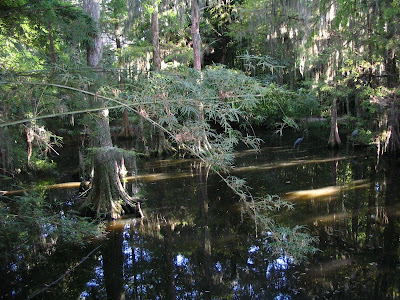
Well it's been a busy week getting back to work and getting my papers for school submitted before this class is done. As promised, I will give a brief post on my trip to Charleston. I went for a week long conference for psychiatric nurses, the conference was great, very interesting and I met a lot of people that I plan to stay in contact with regarding 'standard' practices for psychiatric interventions. It's nice to see so many other nurses that are passionate about the same things I am! Many of the days I was in classes for 12 hours, but I still found some time to see the sights and visit the tourist attractions. Charleston is famous for its historic place as the most busy port of the United States. 80% of the slaves came through their port, they were also the largest exporter of rice from the States at one time. The slaves brought over their expertise of agriculture and growing rice, and most of the plantations down there were rice plantations until the civil war, when the slaves were freed and running the plantations were no longer profitable.
I was able to spend a day at the Magnolia Plantation of the Drayton family.  This plantation has been owned by the same family since it was founded in 1676. It was largely a rice plantation prior to the Civil War, after the civil war, the family sold off 2500 of its 3000 acres and converted part of the rice fields to a garden for people to visit, that opened in 1870. The original family still owns the property, and many of the gardeners that work at the gardens are direct descendants of the slaves brought over a few hundred years ago. The historical society has developed a new tour incorporating the slave houses and a view of living conditions for the slaves and following freed gardeners from 1850 all the way to the 1990's when the last family moved out of these homes located on the plantation grounds and lived in by the gardeners and their entire families. In the 1970's the current gardener raised a family of 13 children with his wife in one of these small houses.
This plantation has been owned by the same family since it was founded in 1676. It was largely a rice plantation prior to the Civil War, after the civil war, the family sold off 2500 of its 3000 acres and converted part of the rice fields to a garden for people to visit, that opened in 1870. The original family still owns the property, and many of the gardeners that work at the gardens are direct descendants of the slaves brought over a few hundred years ago. The historical society has developed a new tour incorporating the slave houses and a view of living conditions for the slaves and following freed gardeners from 1850 all the way to the 1990's when the last family moved out of these homes located on the plantation grounds and lived in by the gardeners and their entire families. In the 1970's the current gardener raised a family of 13 children with his wife in one of these small houses.  The tour is great as it focuses on the amazing journey of the slaves, and what they brought to America. It really turns the focus from the white, rich plantation owners, and shows the culture native to the African slaves that is still a part of the Gullah people today. They also give the credit for the plantations, huge exports of rice crops, the technology of growing these crops in this environment where it belongs, with the slaves who brought it over here and made it happen.
The tour is great as it focuses on the amazing journey of the slaves, and what they brought to America. It really turns the focus from the white, rich plantation owners, and shows the culture native to the African slaves that is still a part of the Gullah people today. They also give the credit for the plantations, huge exports of rice crops, the technology of growing these crops in this environment where it belongs, with the slaves who brought it over here and made it happen.  The gardens are beautiful and vast.
The gardens are beautiful and vast.  There are train tours and walking tours and even a swamp to walk through. Alligators lurk in the murky black waters of the flooded rice fields and blue herons fly gracefully through the marshes.
There are train tours and walking tours and even a swamp to walk through. Alligators lurk in the murky black waters of the flooded rice fields and blue herons fly gracefully through the marshes.  It was a great way to spend an entire day, learning about the culture, seeing the reality of the slave trade and the damage suffered to much of the South on a personal level, and even environmentally, at the culmination of the Civil War.
It was a great way to spend an entire day, learning about the culture, seeing the reality of the slave trade and the damage suffered to much of the South on a personal level, and even environmentally, at the culmination of the Civil War.
My first day in Charleston was very memorable for me. The tours, the sights and the guides with all their information, really gave me a sense of the history of the city, and a window to some of the history of our nation in its early years.






0 comments:
Post a Comment